Speak to one of our experts now about this offer
Call us on - 0800 092 4444
Or drop into your local Kuoni store to find out more
Speak to one of our experts now about this offer
Call us on - 0800 294 9710
Or drop into your local Kuoni store to find out more
Speak to one of our experts now about this offer
Call us on - 0800 294 9728
Or drop into your local Kuoni store to find out more
Whether it’s an island palace on the banks of Lake Pichola, a boutique tea plantation overlooking the Himalayas or a remote safari lodge for the wild at heart, hotels in India are as beautiful and diverse as the country itself. Mughal resorts have sublime Taj Mahal views and stunning pools, private houseboats in Kerala come complete with a small crew and The Serai’s ultra-luxe tented camp is the embodiment of desert sophistication.
But perhaps the best way to get a real sense of India is to experience their proud tradition of hospitality first-hand. According to the Hindu-Buddhist philosophy of atithi devo bhava, guests are regarded as gods. Choose a family homestay and you’ll get a taste of real Indian life, from restored farmhouses in the Udaipur hills to Jaipur heritage havelis and a farm in the Keralan backwaters. Enjoy home-cooked meals with your hosts and unique activities, be it temple visits, tea plantation tours or cooking classes.
Our hand-picked India hotels and resorts focus on wellness and retreat, sublime service, authentic rural lodgings and marble-covered opulence perfectly positioned for historic landmarks.
Mumbai by Dawn
If you want to see Mumbai at its best and meet the real people of the city, this is the tour for you. It’s worth the early start to see the city as it wakes, when it’s cooler and the industrial morning routines are in full swing. This trip really gives you an insight into the spirit and culture of Mumbai.
If you want to see Mumbai at its best and meet the real people of the city, this is the tour for you. With a pick-up at 5.15am, it’s worth the early start to see the city as it wakes, when it’s cooler and the industrial morning routines are in full swing. Down at the docks, watch the Koli fisher-folk, the original Mumbai inhabitants, hauling and grading 25 tonnes of fish straight from the boat. Led by a Mumbai storyteller, you’ll learn all about this community and migration in Mumbai, meeting people who’ve come from all over to make a living here, from fishermen to flower women.
Next stop is the newspaper distribution centre where vendors sort newspapers in seven different languages in the middle of the road. Unlike the rest of the world, the newspaper industry in Mumbai is thriving. You’ll delve into why this is and talk to some of the staff to learn how the printing industry works. The office is near the Victoria Terminus railway station, which you will visit to see its awesome architecture. Next visit a Synagogue, where you’ll learn about Judaism and other religions in Mumbai.
At the market, you’ll encounter all kinds of colourful produce and learn what’s endemic to the country, it’s a very popular photography stop. You’ll see more morning activity, from milkmen driving past to the bustle at the flower market. This trip really gives you an insight into the spirit and culture of Mumbai.
Varanasi on Foot - Kashi, The City of Light
Discover the spiritual and religious sites of India’s holiest city as you follow ancient paths to Hindu temples and Muslim mosques. Witness the cremation rituals observed at Manikarnika, the burning ghat, an important part of Hinduism, then visit the Kashi Vishwanath Temple. Held as one of the most sacred Hindu temples in the world, it is one of twelve jyotirlingas which are special shrines dedicated to the Hindu god, Shiva. A passport is required to enter the temple.
Old Agra: The Road not Taken
Delve beyond the major tourist attractions and explore the little-visited area of Old Agra. Once you’ve seen the Taj Mahal and Agra Fort, this tour is ideal for getting under the skin of this former imperial capital taking you down its hidden lanes and alleyways. Get an intimate glimpse into daily life and the city's history from the late Mughal days to the rule of the British Raj. Take a peek in shops and temples and discover a fascinating, untold history of life before and after the Taj Mahal.
Walking Tour of Old Amritsar
Join a local English-speaking guide as you make your way through the city of Amritsar on foot. You’ll walk through narrow streets and markets and learn about day-to-day life in the city and the Sikh religion. A stop will be made at the Saragarhi Memorial Gurudwara which was built by the British in tribute to 21 Sikh soldiers who faught in the 1897 Battle of Saragarhi. The tour concludes with a visit to northern India’s most famous sights – the Golden Temple.
Fort Cochin & Mattancherry walking tour
Head out into Fort Cochin and Mattancherry with a local guide to discover more about the fascinating heritage of these historic regions. Learn about the importance of Fort Cochin as the entrance to the port and how the Arabic, Chinese, Dutch and Portuguese settlers shaped its architecture and culture. Mattancherry is the heart of historic Cochin and is home to many of the city’s main sights such as the Mattancherry Palace, Jewish Synagogue and Jain Temple.
Evening Bazaar, Cuisine & Crafts of Old Jaipur
Since the founding of Jaipur in 1727, its artisans and craftspeople have sold their respected creations and still use traditional methods to craft items today. Meet your local guide at Hawa Mahal, or ‘Palace of the Winds’, and walk through the bazaar as you chat to locals and try authentic street food. Taste freshly made pakora, samosa and traditional sweets and observe jewellers and silversmiths as they work at their craft.
Chennai's Koyambedu Vegetable & Flower Market
Rise early for a visit to Chennai’s vibrant and lively Koyambedu fresh vegetable and flower market and experience a riot of colours as the vendors set up for the day. The market is one of the largest of its kind in India, covering the area of three football pitches. You’ll make your way through the three sections – the flower market, fruit market and vegetable market – and discover how hundreds of tonnes of produce are transported here from numerous nearby villages.
Mumbai Dreams Bollywood Tour
Experience the madness that is Bollywood, from joining a dance workshop to visiting a working film set and trying your hand at dubbing in the sound studio. Bollywood is such an integral part of Indian culture and the stars are revered as role models.
Experience the madness that is Bollywood, from joining a dance workshop to visiting a working film set and trying your hand at dubbing in the sound studio. Bollywood is such an integral part of Indian culture and the stars are revered as role models.
The full-day tour kicks off with a Bollywood dance workshop led by a professional choreographer, who’ll teach you ten minutes of an iconic dance routine. Your performance will be recorded to take away on a USB. Next, you’ll visit a production studio where you’ll watch a film or TV shoot in action. It’s very immersive and you’ll get a chance to chat with actors and crew in between takes.
After lunch (own expense), head to the recording studio where you can try dubbing some Bollywood dialogue over a film clip. You’ll be given a classic Bollywood line often about the underdog’s place in society and triumphing over bad guys, and then you’ll perform it in Hindi to the clip. It’s great fun and you get an idea of how hilariously over the top Bollywood can be. If there’s time after the studio tour, you can visit the Bollywood Museum to see hand-painted movie posters before ending the trip at an old-school theatre, where you’ll watch an excerpt of a Bollywood movie.
Varanasi on Foot - Northern Bazaars & Hidden Alleys
On this tour you will explore the snaking alleys and busy bazaars in the north of Varanasi, which is rarely visited by tourists. Led by a local guide, you'll visit the silk market, temples and mosques. Along the way, you’ll meet local characters, the experience provides a real insight into Varanasi life that’s tourists often miss.
On this tour you will explore the snaking alleys and busy bazaars in the north of Varanasi, which is rarely visited by tourists. Led by a local guide, you’ll start in the centre of the business area, which is filled with shops, houses and temples. This ancient district is home to the wholesale silk market, which was started by a businessman and the king of Varanasi and takes over an entire city block. Your guide will explain the history of the Asian Silk Route and how Varanasi’s finest silks made their way to Versailles Palace in France. Other highlights include the pots and pans bazaar and a famous samosa shop that dates back to the 1800s.
You’ll also get to visit temples and mosques hidden within the alleyways that only locals know about. There’s a Gopal temple and next to it, a mosque, which is a great place to discuss how Varanasi’s Hindu and Muslim people live and work together in harmony; Muslim people traditionally made silk products here and Hindu’s sold them on. You will also visit the riverside where the mystic Kabir used to write poetry before diving into the twisting back alleys again. Along the way, you’ll meet local characters - perhaps stopping to talk to a sweet vendor or a priest at the temple – the experience provides a real insight into Varanasi life that’s tourists often miss.
Taj Mahal by Sunrise
Every day, the Taj Mahal, India’s most famous World Heritage Site, will see on average 15,000 people. Visit at dawn though and you cut those numbers right down resulting in a more peaceful stroll around the magnificent monuments. The early hours really are the best time to visit when you can just sit quietly and listen to the birds as you take in its architectural beauty.
Every day, the Taj Mahal, India’s most famous World Heritage Site, will see on average 15,000 people. Visit at dawn though and you cut those numbers right down resulting in a more peaceful stroll around the magnificent monuments. The early hours really are the best time to visit when you can just sit quietly and listen to the birds as you take in its architectural beauty.
When the sun starts to rise on a clear day, you can see the mausoleum turn from gold yellow to orange to a sparkling mountain white. You can roam the splendid gardens decorated with fountains and inspect the ornamental craftwork without the crowds. As the sun slowly bathes the walls, the stunning pietra dura inlay lights up the whole façade. This only occurs during the hours of dawn and makes the early start well worth it.
Confluence of Culture - Calcutta Walking Tour
Take a journey around the melting pot of Calcutta’s local communities. Visit the locales of the city’s diverse groups – stop at the colourful Anglo-Indian Bow Barracks and learn about the visit Tiretta Bazaar, the home of Calcutta’s Chinese community where a typical breakfast consists of momos (a South Asian dumpling). Your tour ends at Calcutta’s oldest wholesale market, Burra Bazaar, where you can buy anything from silk saris to delicious street food.
Wagah Border Excursion, Amritsar
When you arrive at the Wagah-Attari border closing ceremony, otherwise known as the ‘flag lowering ceremony,’ you might think you’ve arrived at a football match rather than the meeting of two ideologically opposing countries. Despite the historical tension, every evening, both countries come together to celebrate the closing of the border. It’s more like a flamboyant performance to the tune of patriotic music and there’s still some harmless rivalry though which makes it good fun.
When you arrive at the Wagah-Attari border closing ceremony, otherwise known as the ‘flag lowering ceremony,’ you might think you’ve arrived at a football match rather than the meeting of two ideologically opposing countries. Despite the historical tension, every evening, both countries come together to celebrate the closing of the border. Since 1959, Indians have gathered on one side of a paved promenade while the Pakistan contingent sit on the other.
Both the Indian Border Security Force and Pakistan Rangers dressed in official uniform march down the road past cheering crowds. It’s more like a flamboyant performance to the tune of patriotic music than anything else - synchronised dance movements with slick salutes and high kicks among the many moves on show. There’s still some harmless rivalry though which makes it good fun. The soldiers even sculpt their moustaches in a bid to intimidate their opponents. This all culminates in the lowering of both countries’ flags at the same time as the sun goes down, ending in handshakes between the Indian and Pakistani military.
Sunset cruise, Cochin
Enjoy views of the skyline of the ‘Queen of the Arabian Sea’ from a different perspective on a two-hour sunset cruise. As the sun dips below the horizon, catch the ever-changing colours of the sea and buildings that line the shores of Lake Cochin. Keen photographers will have the opportunity to catch an iconic shot of the famous Chinese fishing nets silhouetted against the vibrantly coloured skies (weather dependent).
Temples of Khajuraho
Explore a collection of the original 85 majestic Temples of UNESCO World Heritage-listed Khajuraho on this half-day tour. The most famous in the western group is Kandariya Mahadeva, which features exquisitely carved friezes depicting the sensual aspects of life. The eastern group boasts fine examples of both Jain and Hindu temples, including the beautiful Parsvanath temple.
Taj Mahal & Agra City Tour
On this tour you will two major attractions, Agra Fort and the Taj Mahal, one of the Seven Wonders of the Modern World. Start at Agra Fort where your guide will explain in detail how the Mughal dynasty created this paradise of beautiful gardens, fountains and architecture. Next you will head to the Taj Mahal stopping at the Mehtab Bagh gardens which enjoy magnificent panoramas of the glorious ivory-white structure. You will then be in front of one of the most beautiful buildings ever made.
On this tour you will two major attractions, Agra Fort and the Taj Mahal, one of the Seven Wonders of the Modern World. Start at Agra Fort where your guide will explain in detail how the Mughal dynasty created this paradise of beautiful gardens, fountains and architecture.
You will go through several gates to a palace called Jahangiri Mahal where inside you can discover all the different architectural influences, not just Islamic, but also Jain and Hindu. Next, head to the Octagonal Tower from where you can see all the way to the Taj Mahal.
Next you will head to the Taj Mahal stopping at the Mehtab Bagh gardens which enjoy magnificent panoramas of the glorious ivory-white structure. As you get closer, the Taj Mahal’s landscaped gardens will come into full view, lined with abundant trees, fountains, symmetrical paths and canals. You will then be in front of one of the most beautiful buildings ever made. The façade has been designed to impress from every angle with perfectly aligned arches and beautiful stonework decorated with flowers and inscriptions of verses from the Koran. The interior contains more architectural marvels such as the huge marble domed tomb. You will have some free time to explore at your own pace and there will be plenty of photo opportunities.
Half-Day Calcutta City Tour
Get to know the city on this tour of its finest attractions. Stop at the elaborate Jain temple and the Kalighat Kali Temple, dedicated to the Hindu goddess Kali. The grand Victoria Memorial showcases some of the most stunning blends of Renaissance and Mughal style and on your drive you’ll pass Calcutta’s famous landmarks including Howrah Bridge, Benoy-Badal-Dinesh Bagh (formerly known as Dalhousie Square) and the 18th-Century Fort William.
Pondicherry's French Quarter Walking Tour
Pondicherry holds so many fascinating secrets that you’d miss if you walked around by yourself. The British conquered a massive part of India, however Pondicherry was ruled by the French, so the whole ambience and culture is completely different. There is the Tamil Quarter as well as the French Quarter, and they’re equally important, so you have to visit both to get a clear picture of this town.
Pondicherry holds so many fascinating secrets that you’d miss if you walked around by yourself. The British conquered a massive part of India, however Pondicherry was ruled by the French, so the whole ambience and culture is completely different. There is the Tamil Quarter as well as the French Quarter, and they’re equally important, so you have to visit both to get a clear picture of this town.
There’s the beautiful French colonial architecture, which has nothing to do with the French architecture in France. On this three-hour walking tour you will be taken along the promenade and shown some of the French houses and explain their unique design. Then you will be taken to the Indian side where it will be explained how they’re built and why, which involves a combination of science, superstition and religion.
The town’s spiritual side is just as eclectic. You will visit its most famous temple, dedicated to Ganesha; visit the renowned ashram; and to a couple of churches. Along with the sights, there’s a lot of storytelling to help people understand something of the ethos of Pondicherry. A stop will be made for a coffee, a South Indian filter coffee made with chicory and coffee and served in a bowl with a small glass. It’s just coffee, so simple, but it brings together the French and Indian influences and is a classic South Indian experience.
Udaipur City Tour, Rajasthan
Udaipur is known more glamorously as the Venice of the East due to its many stunning manmade lakes. The city was founded by Maharana Udai Sing II in 1553 when he transferred the capital of the kingdom of Mewar from Chittorgarh to Udaipur. Start the morning at the City Palace overlooking Lake Pichola. Afterwards, head to the banks of the Fateh Sagar Lake to Saheliyon Ki Bari, otherwise known as the Garden of the Maidens.
Udaipur is known more glamorously as the Venice of the East due to its many stunning manmade lakes. The city was founded by Maharana Udai Sing II in 1553 when he transferred the capital of the kingdom of Mewar from Chittorgarh to Udaipur. Nowadays you’ll find plenty of beautiful hotels here including the Lake Palace hotel which featured in the James Bond movie, Octopussy.
Start the morning at the City Palace overlooking Lake Pichola. It’s a beautiful location, chosen strategically for the protection given by the surrounding forests and hills. Maharana Udai Singh II first visited the palace while on a hunting trip. Reportedly he met a hermit who subsequently advised him to build a glorious capital where he could rule his descendants for centuries. Over 400 years, his successors made various additions to the complex forging the palace into the impressive structure you see today. The main attraction is the mor-chowk (peacock courtyard) decorated with tiny pieces of coloured glass and mirrors. You’ll find a museum with paintings, an armoury and one of the largest crystal collections in the country.
Afterwards, head to the banks of the Fateh Sagar Lake to Saheliyon Ki Bari, otherwise known as the Garden of the Maidens. It was reportedly built by the Maharana for his queen and her 48 royal ladies to enjoy themselves away from court. The queen and her entourage would arrive by palanquins, (carriages) and stroll, relax and play games. The site itself is very tranquil with fountains, lily pads and elephant statues.
Colonial Walk
Explore Mumbai’s colonial history on this half-day tour, led by a local storyteller. The tour focuses on the tales behind the city’s famous colonial buildings, not just the dates and facts. These landmarks are woven into Mumbai’s past, set against a backdrop of modern Indian culture.
Explore Mumbai’s colonial history on this half-day tour, led by a local storyteller. The tour focuses on the tales behind the city’s famous colonial buildings, not just the dates and facts. These landmarks are woven into Mumbai’s past, set against a backdrop of modern Indian culture; people still work at the BMC building and thousands of travellers pass through the Victoria Terminus Station every day. It is a living heritage and a vital part of understanding the city.
The tour starts at the Victory Arch, the Gateway of India, which was built to commemorate King George V. Continue to key sites like the high court and Yacht Club, which are examples of stunning colonial architecture. At the police headquarters, which used to be the Royal Alfred Sailors’ Home, you’ll learn about its connection with the film Alien – the film director Ridley Scott named the spaceship Narcissus after a boat in one of Joseph Conrad’s books, which was set in Mumbai.
Highlights include the Regal Cinema, where you’ll hear about the first Bollywood film that came to Mumbai and a visit Watson's Hotel, which hosted Mark Twain and was the city’s first iron cast building, located in the Kala Ghoda art district of Mumbai. Guests love meeting the Dabbawalas, the couriers who deliver over 500,000 lunch boxes in the city per day, with a staggering 99 percent accuracy despite the fact that they still work without any kind of technology.
Khau Gully
If you love street food, this tour of Mumbai’s Khau Gully, which translates to food lane, is a must. This trip was devised to give travellers an understanding of what quintessential street food is like in Mumbai. You’ll visit the city’s various communities and hear the stories behind their dishes and ingredients. It’s one of the best ways to learn about Indian culture and history because there’s so much woven into food, from migration to politics.
If you love street food, this tour of Mumbai’s Khau Gully, which translates to food lane, is a must. This trip was devised to give travellers an understanding of what quintessential street food is like in Mumbai. You’ll visit the city’s various communities and hear the stories behind their dishes and ingredients. It’s one of the best ways to learn about Indian culture and history because there’s so much woven into food, from migration to politics.
Foodies rave about this experience; you get to taste around eight different dishes over three and a half hours. You’ll try signature snacks like the Bombay burger and bhel puri, which is made of puffed rice, vegetable and tamarind sauce. People enjoy the pav bhaji, a vegetable curry with bread that was loved by workers from Mumbai’s cotton mills. You’ll also get to visit some of the oldest restaurants in Mumbai, including a famous puri. Then there’s the 100-year-old Irani cafés that sprung up in the early 19th century, when bakers migrated here from Iran. Here you can enjoy tea and to meet the people who’ve been running the cafés for what feels like eternity.
The tour ends in Girgaon Chowpatty beach, where you’ll witness real street food culture. On a Sunday, when families want to escape the kitchen, they get dressed up and go down to eat at the beach. You can sample treats like dosas from southern India that have been adapted Bombay style.
Chandni Chowk by Night
Exploring Chandni Chowk by night gives you a chance to understand the real spirit of Delhi. At night, it’s less crowded so there’s more opportunity to engage with locals and after sunset, Chandni Chowk glows and glitters with store lights. There’s a maze of different streets to discover that specialise in everything from silver and spices to saris and glass bangles. If you want to buy something, you guide will help you haggle, which is a ritual in Old Delhi. The highlight of the trip is trying some of the local food.
Exploring Chandni Chowk by night gives you a chance to understand the real spirit of Delhi. It’s like a movie unfolding around you, a whirl of architecture and food, history and business. At night, it’s less crowded so there’s more opportunity to engage with locals and after sunset, Chandni Chowk glows and glitters with store lights. There’s a maze of different streets to discover that specialise in everything from silver and spices to saris and glass bangles. If you want to buy something, you guide will help you haggle, which is a ritual in Old Delhi.
The tour starts at around 5.30pm exploring on foot, as your guide explains the evolution of Old Delhi. You’ll see various businesses and have the opportunity to sit with people and hear about their lives. You might meet the ear-cleaning-man, who wears a red hat and carries tools to remove wax from people’s ears – it’s a great photo opportunity as is the chai vendors swirling tea in their metal pans. As you walk, your guide will point out religious landmarks like the Sunehri Masjid and Gurudwara Sis Ganj Sahib, a Sikh temple with a community kitchen.
The highlight of the trip though is always the food. You will have dinner at Karim’s (guest to pay directly), a restaurant that serves Mughlai cuisine. It was set up in the 1940s by Karim, a chef who served in the kitchen of a Mughal emperor and wanted to introduce this food to ordinary people. The dishes have a Persian influence and include lots of bread and kormas, all cooked in an open kitchen. Afterwards, wander around the street food area where you can sample desserts like bread pudding and mango ice cream. You’ll get to try everything from samosas to chai – food is a very important part of experiencing Old Delhi.
Get a taste of Old Delhi with a local
Let me show you my Delhi – along the way, you’ll meet the locals and discover that everyone has a story to tell…By Dhruv Gupta Founder of Masterji Kee Haveli, Alfred&'s partner in India
Let me show you around the Sitaram Bazar in Old Delhi, where I’ll introduce you to the people, monuments and food that make our city so special. My family is one of the oldest in this part of Delhi – I’m the fifth generation – and I’ve been leading these tours for 10 years now. I believe people today want to connect with local culture when they travel and that’s exactly why I created this tour. It’s a great introduction to Delhi and is also inspired by my passion for food; in my past career I set up the catering department for Japan Airlines.
The half-day trip is flexible and can be tailored to your specific interests, be it photography or history. It’s a personal experience that feels more like a friend showing you around. After meeting at the Chawri Bazar metro station, I take guests to a breakfast place where they make their own bread because if the stomach is happy, everyone is happy! We usually visit a temple next and then wander the back alleys of the bazar, stopping at hidden terraces where you get amazing views over Delhi. There’s also a chance to take a rickshaw ride and visit some architectural treasures.
People enjoy spending time at Asia’s largest wholesale spice market and sampling street food favourites like samosas and pav bhaji. Along the way, you’ll meet the people of Old Delhi and quickly discover that everyone has a story to tell. We finish with a big vegetarian meal at my haveli, which is an oasis in Delhi. This is the highlight of the whole experience; guests love sitting together, chatting and making friends. I had a guest recently who told me: “If my trip ends today, I’m happy,” which is the best compliment I can imagine.
A Day in the City of Nawabs
This walking tour of Lucknow is a must if you want to understand the history of the city, its Nawab and colonial roots. Tours are led by knowledgeable local guides who can connect stories of the past with the present. As you’ll discover, the city is a blend of French, British and Nawab history as well as Shiite culture – Lucknow has the largest population of Shiite people outside of Iran.
This walking tour of Lucknow is a must if you want to understand the history of the city, its Nawab and colonial roots. Tours are led by knowledgeable local guides who can connect stories of the past with the present. You’ll start with a short horse-drawn carriage ride into the heart of the city and then explore some of Lucknow’s most important buildings and medieval markets. As you’ll discover, the city is a blend of French, British and Nawab history as well as Shiite culture – Lucknow has the largest population of Shiite people outside of Iran.
The monuments you will visit tell the story of the Nawabs, who ruled this region in the 18th and 19th century, followed by the British until India won independence in 1947. Sights include the ruins of a palace destroyed during the fight for freedom and the site where the last Union Jack flag was pulled down. You will spend a lot of time at The Residency, where the siege of 1957 occurred and around 3,000 British men, women and children died. It’s a powerful story of tragedy and struggle for liberation. You’ll also explore Dilkusha Park, where the British general Henry Havelock died.
Another key stop on the tour is La Martiniere, which was constructed by a soldier who switched sides from the French East India Company and rose to become a major general in the British force. Now a school, La Martiniere is known for its stunning architecture. It’s here that you’ll learn the story of Major William Hodson, another infamous figure in British colonial history, who’s buried here.
Culinary Walk
Explore Awadhi cuisine, which is unique to this region, on a popular evening food walk. Led by a food expert, you’ll hop from place to place, testing the signature dish at each eatery such as Lucknow’s famous melt-in-the-mouth kebab. The walk starts around 7pm when the food stalls and shops are in full swing. At each stop, your guide will talk you through the origins of the dishes you will sample, many are age-old recipes that have been passed down through the generations and are still cooked with traditional utensils and roasted over charcoal
Explore Awadhi cuisine, which is unique to this region, on a popular evening food walk. Led by a food expert, you’ll hop from place to place, testing the signature dish at each eatery such as Lucknow’s famous melt-in-the-mouth kebab – these cooks are the masters of their trade. You’ll be taken to the places locals love; they might not look fancy but you just have to close your eyes and let your taste buds do the work.
The walk starts around 7pm when the food stalls and shops are in full swing. At each stop, your guide will talk you through the origins of the dishes you will sample, many are age-old recipes that have been passed down through the generations and are still cooked with traditional utensils and roasted over charcoal. You’ll learn about Awadhi food, which is a refined version of Mughlai cuisine with colonial influences from the British and French, as well as Persian flavours added by the many Shiites who’ve migrated to Lucknow.
Over the course of an hour and a half you’ll taste everything from tender water buffalo skewers to halva and goat meat with rice that’s been cooked in a sealed pot so it marinates in its juices. A highlight of the tour is trying Nihari gosht, trotters stewed overnight in mustard oil and chickpea flour, served with a flaky pastry to absorb the sauce. The mustard oil is buried under a tree through the monsoons and takes the aroma of the raindrops – it’s one of the favourite dishes of Lucknow.
Meet the Nawab of Lucknow
Have tea with the famous Nawab Jafar Mir Abdullah, who’ll give you a unique insight into the former Nawab rulers who governed Lucknow in the 18th-19th centuries. The meeting takes place in the museum, surrounded by antiques and family heirlooms that Jafar often rents out to Bollywood films.
Have tea with the famous Nawab Jafar Mir Abdullah, who’ll give you a unique insight into the former Nawab rulers who governed Lucknow in the 18th-19th centuries. You’ll head to his house, a former palace, for tea at around 4.30pm, usually after a history tour of the city. The meeting takes place in the museum, surrounded by antiques and family heirlooms that Jafar often rents out to Bollywood films. While exploring the city, you will have heard all about the Nawabs so this is a special opportunity to meet one in person.
Enjoy a cup of chai accompanied by cookies, sandwiches and Indian snacks as you get to know Jafar. He’s a very charismatic, articulate man and an ambassador who appears on postcards because of his typical Nawab appearance. On his mother’s side, Jafar can trace his family’s roots back to the royal Nawabs of Lucknow and he has all sorts of stories and anecdotes to tell, including what life was like in British colonial times.
Cooking Class & Lunch at Bamboo Retreat, Rumtek
Bamboo Retreat is perfectly positioned in the fertile foothills of the Himalayas and showcases ethnic cuisine. The focus is mainly on Tibetan and northern Indian food such as momo dumplings and the noodle soups you find in Sikkim. Bamboo Retreat has the benefit of its own farm which makes for the freshest lunches using cow peas, mung beans and fava beans to make dal.
Bamboo Retreat is perfectly positioned in the fertile foothills of the Himalayas and showcases ethnic cuisine. The focus is mainly on Tibetan and northern Indian food such as momo dumplings and the noodle soups you find in Sikkim. When you arrive at the retreat, you will be offered a range of herbal teas including mint and stevia grown from the garden. If it’s a sunny day you can admire the city of Gangtok surrounded by mountains and acres of lush green farmland.
Bamboo Retreat has the benefit of its own farm which makes for the freshest lunches using cow peas, mung beans and fava beans to make dal. You will get to see some of the more unusual vegetables, native to Sikkim that aren’t as widely used. For example, water cress and four different types of nettles is made into soup. You don’t have to be a great cook to join the class, but you need to be willing to explore your culinary horizons. You’ll learn just how simple it is to prepare a healthy and delicious meal. Visitors can explore the orchards and gardens growing herbs for medicine, edible flowers, and fruit to make jams.
Day Trip to Dhami with Lunch
Experience life in a traditional Himalayan village, where you’ll explore and dine with a local. The trip starts with a 45-minute drive from Shimla to Dhami, a village that was once a summer hunting ground for British viceroys, where you’ll meet your host who has expert knowledge of the area’s nature, lifestyle and architecture. This is a fascinating cultural exchange where you’ll get an insight into rural Himalayan life, where people survive on agriculture, working in the fields and orchards.
Experience life in a traditional Himalayan village, where you’ll explore and dine with a local. The trip starts with a 45-minute drive from Shimla to Dhami, a village that was once a summer hunting ground for British viceroys. There you’ll meet your host, Kunwar Dushyant Singh, who has expert knowledge of the area’s nature, lifestyle and architecture.
Kunwar will lead you on a nature walk in Dhami, where he’s identified around 80 species of birds, from thrushes to goldfinch and pheasants. The flora varies depending on the time of year, spring is particularly beautiful with alpine flowers while in autumn, you can watch the leaves change colour. There are amazing views of the northern mountains when the sky is clear, you can even see the snow-topped peaks of the Himalayas.
Kunwar will point out key landmarks and tell you all about his family history and life in a farming village. After the walk, you’ll return to Kunwar’s house to eat with his family. The food is home-cooked by his wife, who hails from the royal family of Tikamgarh. She makes typical Indian cuisine from the mountains, including lentil and bread dishes, as well as dumplings cooked in a large iron pan with mustard oil, served with yoghurt.
This is a fascinating cultural exchange where you’ll get an insight into rural Himalayan life, where people survive on agriculture, working in the fields and orchards, keeping cows and buffalos. If someone in the village needs to build a house, the whole community will come out to help and if there’s a marriage, everyone celebrates. It’s a close-knit place and the people are very welcoming.
Day of the Buddha
Experience Buddhist culture in Dharamshala on this full-day tour, with visits to Tibetan temples, nunneries and the Dalai Lama’s monastery complex. Start with a Kora around the residence of his holiness, this is a Tibetan Buddhist ritual of walking in a clockwise direction around a sacred site. You’ll see prayer flags and old ladies spinning prayer wheels and chanting – the views of the mountains are also spectacular and, if the weather is clear, you can see the Kangra Valley below. You will get to visit the main temple where the Dalai Lama conducts his teachings as well as the Kalachakra temple with its murals of tantric deities.
Experience Buddhist culture in Dharamshala on this full-day tour, with visits to Tibetan temples, nunneries and the Dalai Lama’s monastery complex. Start with a Kora around the residence of his holiness, this is a Tibetan Buddhist ritual of walking in a clockwise direction around a sacred site. You’ll see prayer flags and old ladies spinning prayer wheels and chanting – the views of the mountains are also spectacular and, if the weather is clear, you can see the Kangra Valley below.
You will get to visit the main temple where the Dalai Lama conducts his teachings as well as the Kalachakra temple with its murals of tantric deities. If you’re lucky, you might even get to watch a debate taking place. From there you will be driven to the Gyuto Tantric Monastery where around 700 monks live, it was founded by Tibetans who fled to India. A highlight is watching the monks in yellow hats chanting in the so-called Tantric Choir.
The Buddhist circuit continues at the famous Norbulingka Institute where you’ll learn about their work preserving Tibetan art and culture. They hold workshops in painting, appliqué and wood carving. Lunch will be at the Humming Bird Café, (guest to pay directly) which serves Tibetan cuisine like momos, mutton dishes and vegetable noodle soup. The tour ends with a trip to the Dolma Ling Nunnery, which is the first institute for the higher education of Tibetan Buddhist nuns.
Walking Around Garli Village
Take a scenic walk to Garli, which was a thriving village in the sub-Himalayan region until India’s independence. The streets here are cobbled and filled with history, you can still see its grand havelis and Italianate buildings, as well as traditional Kangra and Rajput houses with mud-plastered walls and slate roofs. For those who love heritage and architecture, it’s a real treat.
Take a scenic walk to Garli, which was a thriving village in the sub-Himalayan region until India’s independence. The streets here are cobbled and filled with history, you can still see its grand havelis and Italianate buildings, as well as traditional Kangra and Rajput houses with mud-plastered walls and slate roofs. For those who love heritage and architecture, it’s a real treat.
Most of the buildings have been well looked-after, so you can still enjoy the detailed tiling, towers and stained-glass windows. Led by a guide from Judge’s Court, the walk to Garli takes you through the area’s hills and countryside, surrounded by the backdrop of the Dhauladhar Mountains. Along the way, you’ll learn all about life in the sub-Himalayas and the history of the area, from how Pragpur’s medieval water systems work to stories of local residents and the fortress that was used to defend the area. The trail leads all the way to a wonderful hilltop viewpoint.
Periyar Bouquet - Spices & Other Stories
Thekkady is a special place and famous for its spices. You will start at a viewpoint for a lovely view of Thekkady’s town below. Those who can handle the rolling terrain can also do this by bicycle. Here, your guide will explain about the importance of the land. You’re in the Western Ghats, one of the biodiversity hot spots of the world, packed with a huge number of different species, plants and birds. The government now employs natural fertilisers and traditional methods to cultivate the land rather than products such as pesticides. Descending into the village you will meet a couple who grow spices in the surrounds of their family home. The farmer will take you around the plantation to show you all the different plants and spices they grow such as coffee, jackfruit and black tamarind. You will be welcomed as a friend and may offer you some tapioca or home-made chocolate from their cocoa plantation.
On the scent of a local spice farm
Letchmi Hills Trek
Visitors to Munnar are often unaware of its unique beauty. On this guided trek you will be shown the incredible scenery of the region. The Letchmi Hills trek is the closest trek to Munnar town and not only is it beautiful, but the route is flexible. You could add a visit to the tea museum or a trip to a tea plantation should you wish.
Visitors to Munnar are often unaware of its unique beauty. On this guided trek you will be shown the incredible scenery of the region. The Letchmi Hills trek is the closest trek to Munnar town and not only is it beautiful, but the route is flexible. You could add a visit to the tea museum or a trip to a tea plantation should you wish. If you’re arriving after the 4-hour drive from Cochin, it’s the perfect way to get outdoors and stretch your legs while soaking up some wonderful views.
You will start in the tea gardens before moving into grassland and onto a ridge with rocky mountains on one side and tea plantations on the other with patches of tropical montaine forests scattered in between. Starting at 1,350 metres you’ll ascend to a high point of 1,950 metres. From the top you have 360-degree views of some of the highest peaks in the south of India, the undulating valleys and the spice gardens. On a clear day you could see up to thirty mountain ranges including Anaimudi, the highest peak in South India and the waters of Idukki Dam, India’s third highest. During your trek, you may encounter elephants, mongoose and the colourful bird life in this beautiful part of India. The trekking guides are all young and energetic and know the best spots for photographs.
Munnar on Tuk Tuk
Rather than exploring Munnar in an air-conditioned vehicle, a unique way to get a real understanding of the region’s famous tea plantations is by tuk-tuk. Also known as an auto rickshaw, these tuk-tuks are a way of life. Not only are tuk-tuks a fun mode of transport but they’re specifically used by the tea estates to traverse the narrow roads generally inaccessible to most other vehicles.
Rather than exploring Munnar in an air-conditioned vehicle, a unique way to get a real understanding of the region’s famous tea plantations is by tuk-tuk. Also known as an auto rickshaw, these tuk-tuks are a way of life and can be seen throughout India. There’s no need for air-conditioning, it’s just the sun on your face and the wind in your hair as you ride (and bump!) along the dazzling green tea bushes.
Travelling like a local, it’s a totally different experience for guests. Not only are tuk-tuks a fun mode of transport but they’re specifically used by the tea estates to traverse the narrow roads generally inaccessible to most other vehicles. You will start in Munnar town and head to one of the oldest and most beautiful tea estates. Your guide will show you how the workers harvest tea and introduce you to the local village.
Half Day Tea Plantation Tour & Tea Museum
The day starts with a lovely walk perhaps spotting elephants, birds and small deer along the way. Munnar has the perfect British summer climate ranging from 18-28 degrees Celsius. Traverse the tea plantations for first-hand experience of harvesting, speaking to the local tea pickers who often offer insight into the art of leaf picking.
The day starts with a lovely walk perhaps spotting elephants, birds and small deer along the way. Munnar has the perfect British summer climate ranging from 18-28 degrees Celsius. Traverse the tea plantations for first-hand experience of harvesting, speaking to the local tea pickers who often offer insight into the art of leaf picking.
Next it’s onto the tea museum to learn how tea is made followed by a tasting in the dedicated café. This is no ordinary tasting but more of a ceremonial introduction into the nuances of tea and what makes the perfect cup.
Spice Coast Cruises - CGH Earth
In the early days, Keralans used kettuvallam boats to transport rice, passengers and spices between different villages, hence why they were often referred to as rice barges. In keeping with the traditional style woven with bamboo and coir and narrow enough to navigate the canals, you can spend a night or two on Spice Coast Cruise. Cruising on a traditional rice barge is a wonderful way to explore a peaceful side of India.
In the early days, Keralans used kettuvallam boats to transport rice, passengers and spices between different villages, hence why they were often referred to as rice barges. They weren’t motorised so the crew would punt them slowly along the canals stopping at all the markets. After the 1980s, Kerala saw more roads being built and slowly the dominant transport changed from water to land. Responding to the change, the locals transformed their barges into houseboats for visitors who wanted a taste of Lake Vembanad’s idyllic backwater life.
Spice Coast Cruises have two kettuvallums. They are in keeping with the traditional style woven with bamboo and coir and narrow enough to navigate the canals. They both have one bedroom for exclusive use only, so you don’t have to share the views as you sit on the open deck and watch the water world go by. The talented boatmen whose families have navigated the lake over generations, double up as private chefs and cook amazing feasts. Enjoy fish caught from the lake that same morning and cooked in a banana leaf with chilli, ginger and lime. Or the prawns picked from the ponds accompanied by red rice and locally grown vegetables. It’s always fun to buy the fresh catch of the day from a local market and ask the chef to cook it up for supper.
Stay for one night and you’ll experience a slice of Lake Vembanad’s unique lifestyle. You could go for a stroll around a village known for its coir rope making, see fishermen casting their nets and end the day admiring those melting sunsets from the deck. Stay for two nights and you can explore smaller canals and get even closer to village life where farmers work in the paddy fields, people washing their clothes in canals and children racing along the banks after school without a care in the world. Cruising on a traditional rice barge is a wonderful way to explore a peaceful side of India.
Architectural Walking Tour
This tour is a great orientation of Jaipur; you’ll discover its architecture, religion and crafts and meet the locals, learning the stories and legends behind the city. Visit one of the city’s oldest temples, see the architectural sights of City Palace before immersing into some of Jaipur’s hectic markets.
Join a walking tour of UNESCO-listed Jaipur to learn about its architectural jewels. The tour starts at 8.30am when it’s peaceful, before the bazaars and markets take over. This is when locals go to worship and you can join them at one of the city’s oldest temples, which is known for its 300-year-old fresco painting and set in a private family home. This begins a discussion about religion and architecture in Jaipur; where at a junction in the city, you get to see a Jain Temple, a mosque and a Hindu temple.
Continue the walk at Broad Road, which was once used by the royal family, so it’s lined by grand houses. As you enter the winding by-lanes you’ll hear about Jaipur’s history as the first planned city in India, the vastu shastra and shilpa shastra architecture and havelis owned by artists, craftsmen and traders. You’ll get to meet some of these characters when you visit the metal-beating community who still work without technology, in the same way they have for 200 years. It’s fascinating to see how everything has been hand-created. Other key architectural sights on the tour include the City Palace, the Ayurvedic hospital and two huge, 10-foot-tall silver jars which belonged to a king of Jaipur. Guests love visiting a local family in their haveli to chat about life in Jaipur and meeting traditional bangle makers.
You will end the tour with an immersion into some of Jaipur’s hectic markets. There’s the spice market with over 300 shops which draws buyers from far and wide, followed by the vegetable and flower markets. The flower market is always busy with people shopping for weddings and festivals. This tour is a great orientation of Jaipur; you’ll discover its architecture, religion and crafts and meet the locals, learning the stories and legends behind the city.
Cook in a Blue House
This cooking experience takes place in a Jodhpur family home, a typical blue house with rooftop views over the city and Mehrangarh Fort. Your hosts are Brahmins and love to cook; the cuisine is vegetarian. Cooking skills have been passed down through the generations as in India cooking is done communally. You’ll also get to learn about the medicinal benefits of spices in Indian cuisine.
This cooking experience takes place in a Jodhpur family home, a typical blue house with rooftop views over the city and Mehrangarh Fort. Your hosts are Brahmins and love to cook; the cuisine is vegetarian and doesn’t include any onion or garlic.
To start, you’ll learn how to make pakoras with tamarind and jaggery chutney served with masala tea, which you’ll enjoy on the rooftop looking out over the city. The mother of the house will lead the main cooking demonstration, translated by her husband who speaks fluent English. The dishes are made from seasonal vegetables such as eggplant, okra, cauliflower and cabbage. You’ll also make a dahl and chapati followed by a Rajasthan tali and to finish, a sweet such as halva.
Cooking skills have been passed down through the generations as in India cooking is done communally. You’ll also get to learn about the medicinal benefits of spices in Indian cuisine, for example, coriander is good for blood pressure and turmeric is good for your skin. Rather than buy a pre-mix masala, you will be shown how to make it fresh by mixing cardamom, black pepper and ginger. The whole experience takes about two hours, and you will be given handwritten recipes so you can recreate the meals when you get home.
Half Day Sightseeing Tour of the City
Jodhpur, the second largest city in Rajasthan, is also known as the Blue City. As soon as you step into the streets, you will see lanes of beautiful indigo-blue painted houses that belong to the Brahmins, the elite priestly caste of Hinduism. Head to the Mehrangarh Fort, founded by Maharaja Rao Jodha in the 15th century. This magnificent fortress was used as the private residence of the royal family.
Jodhpur, the second largest city in Rajasthan, is also known as the Blue City. As soon as you step into the streets, you will see lanes of beautiful indigo-blue painted houses that belong to the Brahmins, the elite priestly caste of Hinduism. On the way to Mehrangarh Fort which you’ll see located high on a hill above the city, a stop is made at Jaswant Thada, a royal cenotaph built in the later 19th century with white marble brought from the same quarry as that used for the Taj Mahal.
Head to the Mehrangarh Fort, founded by Maharaja Rao Jodha in the 15th century. This magnificent fortress was used as the private residence of the royal family. You enter through Jai Pol, meaning ‘Victory Gate,’ dedicated to the victory over the invading armies of Jaipur. After admiring some beautiful frescoes, walk through Fateh Pol where you can still see the cannonball marks from various attacks. Enter Shringar Chowk, a courtyard where the royal families were coronated. There’s a wonderful museum in which you can see all the elaborate howdahs (seats) that were fastened onto the maharaja’s elephants, made of silver, gold and delicate ivory work. The Flower Palace is another museum highlight with frescoes, miniatures and 24-carat gold leaf work.
The Bandhani Art of Jodhpur
Visit a home in Jodhpur to learn the ancient art of Bandhani – tie dye practiced by the people of Rajasthan and Gujarat. There are about 700 to 800 Muslim families in Jodhpur who practice the Bandhani technique on a daily basis and have been catering to merchants and wholesalers for centuries. Your host for this tour learnt the skill from his grandfather. You will visit the workshop and learn about the textile traditions in India.
Visit a home in Jodhpur to learn the ancient art of Bandhani – tie dye practiced by the people of Rajasthan and Gujarat. There are about 700 to 800 Muslim families in Jodhpur who practice the Bandhani technique on a daily basis and have been catering to merchants and wholesalers for centuries. Your host for this tour learnt the skill from his grandfather. Tie dye has a long history in India that has evolved over time, from the days when only natural paints and hand-drawn designs were used to today’s modern stencils and paints that offer unlimited designs. Every piece created is unique and the most complicated designs can take up to 15 days to complete.
You will visit the workshop and learn about the textile traditions in India. During the demonstration the raw fabric, normally cotton or silk, is cut, folded and secured with stitches. A pattern is marked with iron stencils before tying knots in the fabric. You can then choose the colours and dip the fabric into the dye before the grand reveal of the final design.
Truck Painting Experience
Learn about India’s truck painting tradition at a family workshop in Jodhpur. s you drive through India, you’ll notice trucks decorated with all kinds of colourful pictures and slogans. The practice started to comfort homesick drivers who spend months at a time on the road and miss their families. When you visit the truck painters of Jodhpur, they’ll tell you about their family history and you’ll get to watch them work and even have a go at truck painting yourself.
Learn about India’s truck painting tradition at a family workshop in Jodhpur. As you drive through India, you’ll notice trucks decorated with all kinds of colourful pictures and slogans. The practice started to comfort homesick drivers who spend months at a time on the road and miss their families. So, they paint their trucks with images from home, perhaps of women collecting water in their village, animals grazing, religious celebrations or their family name. Some people also request quirky slogans like Horn Please! They’re fun to look out for as you travel around the country.
Raja is a professional truck painter and along with his six brothers has been painting trucks in Jodhpur for 30 years. As a team, it takes them up to five days to decorate one vehicle, depending on its size and how detailed the design is. When you visit, they’ll tell you about their family history and you’ll get to watch them work and even have a go at truck painting yourself. Visitors really enjoy this interactive experience and have lots of questions about their proud family tradition. After this tour you’ll see trucks with a completely different view.
In the Footsteps of Rajas & Sultans
When people think of Bangalore, they often think of the modern city it is now, however a walking tour will reveal its fascinating history. In the Footsteps of Rajas and Sultans covers the evolution of Bangalore from when it was founded in medieval times to its capture by the British, a fascinating period of time. Explore the crowded bazaars, stopping at interesting sites including the market and an ancient temple. Along the way, your guide will share some intriguing stories about Bangalore.
When people think of Bangalore, they often think of the modern city it is now, however a walking tour will reveal its fascinating history. In the Footsteps of Rajas and Sultans covers the evolution of Bangalore from when it was founded in medieval times to its capture by the British, a fascinating period of time.
The original city started off in 1537 as a mud fort, with a moat around it and a fortified settlement, or pettah, to the north which had different areas for people of a particular location, so there’d be districts of goldsmiths, traders and rice millers. You will weave south along labyrinthine streets that were formed in the 1500s. Explore the crowded bazaars, stopping at interesting sites including the market and an ancient temple. Along the way, your guide will share some intriguing stories about Bangalore.
The two-and-a-half-kilometre walk ends at what’s left of the stone fort built in the 18th century, which was damaged during the British siege of 1791 and later almost completely demolished. All that’s left is one massive gateway, which is a fitting spot to end because it marks the beginning of a new period in Bangalore’s history: the days of the Raj.
SoBa Walk
You’ll see a side of Bangalore that many people don’t even know exists on the SoBa walk. South Bangalore still holds on to its old-school way of life and this guided walk will take you to the temple where you can soak up the sounds and sights as people pay their respects. Wander through the market to enjoy the fresh smell of the flowers and vegetables as you watch the locals busy buying. Along the way, your guide may introduce you to some of the residents.
You’ll see a side of Bangalore that many people don’t even know exists on the SoBa walk. When you look at the city, it has four cities within it that tell you its whole story. The oldest part is right in the centre, then there is the colonial part that the British built. Modern high-tech Bangalore is another part of the city, but this tour focusses on South Bangalore – or SoBa as it is known.
South Bangalore still holds on to its old-school way of life and this guided walk will take you to the temple where you can soak up the sounds and sights as people pay their respects. Wander through the market to enjoy the fresh smell of the flowers and vegetables as you watch the locals busy buying. Along the way, your guide may introduce you to some of the residents.
Admire the beautiful traditional houses built in the 1940s and 1950s, little grocery shops where the customers still bargain for what they want and men and women dressed in traditional attire. Beyond the sights, your guide will also explain about the local culture and the history of the local language, Kannada. This tour provides guests with an authentic sense of what it means to be a Bangalorean, of the relaxed rhythm of every day and of a way of life that’s fast vanishing. SoBa is not modern Bangalore it’s a little time capsule.
Vineyard Visit & Lunch with Local Wine Aficionados
People are often surprised to discover that wine is made in India so a visit to a vineyard on the outskirts of Bangalore is well-worth it. The winery is in a peaceful and beautiful setting at the foot of the Nandi Hills, where Tipu Sultan once had his summer retreat. As you walk around the different parts of the winery, your guide will explain the processes involved in creating a finished bottle of red, white, rosé and sparkling wine.
People are often surprised to discover that wine is made in India so a visit to a vineyard on the outskirts of Bangalore is well-worth it. Kanwal Grover ‘the father of Indian viticulture’ and Georges Vesselle planted the first French varieties of grapes here in 1988, experimenting to see which of 33 different types would work best in the climate and soil.
The winery is in a peaceful and beautiful setting at the foot of the Nandi Hills, where Tipu Sultan once had his summer retreat. The sight of rows of vines stretching away into the distance is magical. Some visitors appreciate the scenery as much as the New World wines.
As you walk around the different parts of the winery, your guide will explain the processes involved in creating a finished bottle of red, white, rosé and sparkling wine. You will go on a journey from sorting and crushing the grapes to labelling and packaging. In the barrel room you can see where some of the more expensive wines are aged in oak barrels. Finally, under the guidance of a professional sommelier, you will get to taste some of the wines you’ve learned about.
Full Day Excursion to Belur & Halebid Temples
Belur and Halebidu’s soapstone temples were built by the Hoysala dynasty who ruled the southern part of India from around 1006 to 1346. They built almost 1500 temples in 950 locations out of which only 80 temples survive today due to various invasions. These are beautiful pieces of architecture and unique in so many ways.
Belur and Halebidu’s soapstone temples were built by the Hoysala dynasty who ruled the southern part of India from around 1006 to 1346. They built almost 1500 temples in 950 locations out of which only 80 temples survive today due to various invasions. These are beautiful pieces of architecture and unique in so many ways.
Belur was the first capital of Hoysala before they shifted it to Dorasamudra now famously known as Halebidu. At Belur, the main attraction is the 1st-century Chennakeshava Temple – chena meaning ‘beautiful’ and keshava being one of the 24 forms of Vishnu. It took almost 103 years to complete over three generations.
Most of the Hoysala temples are cleverly designed with a star-shaped platform called jagati at the base. Some of the most intricate artwork of the era is displayed on the outside of the temple including 38 madanikas (female sculptures) fixed at the end of the pillars. Over the years the weather has hardened the soapstone which gives the exterior a smooth, shiny glean. Inside you’ll see the sculptors’ remarkable work down to the finest detail around the navaranga hall with 48 pillars, most of which are carved by lathe. No two pillars are the same and you won’t find any stone left unfinished. You may even see the sculptors’ signatures which was rare because the kings never really credited the artisans.
After a spot of lunch (own expense) travel to Halebidu temple around a 25-minute drive away. Otherwise known as Hoysaleswara, this twin temple dedicated to Shiva was built around five years after Belur. Here you’ll find two huge monolithic bulls as well as very striking and varied artwork of processions, deities and animated stories – all minute carvings. All of this history is embedded into the walls as there were no written scriptures.
Peacock Trail
The Peacock Trail takes place in Mylapore in the heart of Chennai, a neighbourhood that’s much older than the city itself. When the British arrived, it was a village with pretty houses and ancient temples dating from the time when it was an important port for the Pallava empire, and today it’s a perfect place to show people something of the way of life in the city. The tour is led by people from different walks of life: writers, artists, musicians, bankers and historians, all with a deep interest in the city and a passion to tell its stories.
The Peacock Trail takes place in Mylapore in the heart of Chennai, a neighbourhood that’s much older than the city itself. When the British arrived, it was a village with pretty houses and ancient temples dating from the time when it was an important port for the Pallava empire, and today it’s a perfect place to show people something of the way of life in the city.
The tour is led by people from different walks of life: writers, artists, musicians, corporate people, bankers, historians, all with a deep interest in the city and a passion to tell its stories, of which there are so many. A lot of them are connected to the Kapaleeswarar Temple, where the trail starts. It’s a very famous temple of Shiva, the Hindu god, and the guides focus on the architecture and tell stories about what happens in the temple.
Afterwards, wander through Mylapore’s tiny lanes, which are lined with small houses that were built almost 500 years ago. Learn about the history of those houses and the patterns drawn on the ground outside them and the evil eye that the owners hang outside. There’s a bazaar, a huge temple tank built on land donated by the Muslim ruler at the time and a house belonging to the family of a Brahmin priest, which has some fascinating features. The tour finishes in the old Portuguese settlement of Sao Tome where there is a beautiful church with some unusual decorations.
Trace the Classical Beats of Bharatanatyam
Bharatanatyam is one of the classical dance forms of India. It thrived in the temples, where it was performed for that place’s particular deity. It was designed as a visual way of communicating stories from sacred Hindu texts so that people who were not educated could understand them. Your guide will explain the various hand gestures used to communicate as students perform for guests.
Bharatanatyam is one of the classical dance forms of India. It thrived in the temples, where it was performed for that place’s particular deity. It was designed as a visual way of communicating stories from sacred Hindu texts so that people who were not educated could understand them: the conduct of the society, what is wrong, what is right, the mythological stories. Today it has become an entertainment, but also used as an art form as a language to reach out to people about modern themes. It takes close to 10 years to become proficient in Bharatanatyam.
The session starts with an explanation of how the art form emerged. The technical aspects are then demonstrated, such as the basic steps and how they’re combined to make a sequence. Your guide will explain the various hand gestures used to communicate and the students perform for guests. The end of the session is very interactive, and guests have the chance to show some of the gestures they have learnt. This experience gives people a little gist of what this art form is: where it's coming from, what the basic positions are and other elements such as the music, make-up, and costume. \
Creole Cooking Class
The food in Pondicherry is unique, a fusion of French and Tamil traditions that’s very much part of its cultural identity. During this cooking class you will get to learn what Creole food is, what makes it different and how to prepare it. It’s a really hands-on experience.
The food in Pondicherry is unique, a fusion of French and Tamil traditions that’s very much part of its cultural identity. During this cooking class you will get to learn what Creole food is, what makes it different and how to prepare it. It’s a really hands-on experience and the three hours goes by very quickly.
After an introduction to the story of how Creole cuisine came about, you will talk about the dishes that you’re going to prepare together. A lot of them are based around mutton, such as meatballs cooked with coconut milk, curry leaves or deep-fried chops in chickpea batter flavoured with fennel seeds. If people prefer, vegetarian or chicken options can be prepared.
Start by washing and chopping the vegetables – typically beetroot, potatoes, carrots, onions and tomatoes, plus ginger and garlic – and soaking them in vinegar or turmeric water as a disinfectant. Then start to make the sauces and cook the meat, spices and vegetables and prepare something like a beetroot and egg salad. The last thing that is made is the Rava cake, which is made with semolina. Finally, as you sit and eat all the delicious things you’ve made, there is a chance to ask any final questions to your host.
Kizhur Village Visit
The countryside beyond Pondicherry has so many stories and this tour was created to show guests something of the way of life, the history and the natural beauty. Kizhur is not only authentic, but it’s actually an important place in the story of how Pondicherry got its freedom.
The countryside beyond Pondicherry has so many stories and this tour was created to show guests something of the way of life, the history and the natural beauty. Kizhur is not only authentic, but it’s actually an important place in the story of how Pondicherry got its freedom. You will start at the Kizhur Monument, which commemorates the signing of an agreement in 1954 to make the territory a part of India instead of a colony of France.
Not far from Kizhur, there’s a huge 60-year-old banyan tree that’s been looked after by the same woman for more than 50 years. Its main claim to fame is that it was one of the locations for The Life of Pi film. You will then head into the village to discover how people go about their daily routines. You will visit the house of someone who still makes pottery in the traditional way and you can try creating something for yourself. Walk through the village and see farmers working in the fields growing tapioca or guavas. Visit a coconut grove to watch how the locals pick the fruit. You can also ride in a bullock cart and watch the cows being milked.
Perhaps the most unusual sight for visitors is the nearby temple, which is called ‘a temple of dolls’. It’s surrounded by brightly coloured statues that people have been putting there for around 100 years when their prayers to Ayyanar, the village deity, come true. It’s quite a unique feeling walking among them as there are around 10,000, some of which are as much as 10 feet tall.
Wake-up Pondi Cycling Tour
Bicycle is a perfect way to explore the heart of Pondicherry as you can go along the smallest and quietest of lanes, see the small details you’d miss from a car or bus and really experience the sights, sounds and smells of the town in the cool of the morning. During this relaxed guided two-hour ride, you will visit all four heritage districts – the Muslim, Indian, Sri Aurobindo ashram and French quarters.
Bicycle is a perfect way to explore the heart of Pondicherry as you can go along the smallest and quietest of lanes, see the small details you’d miss from a car or bus and really experience the sights, sounds and smells of the town in the cool of the morning.
During this relaxed guided two-hour ride, you will visit all four heritage districts – the Muslim, Indian, Sri Aurobindo ashram and French quarters. There will be lots of photo stops. Visit Goubert Market, where there are vendors selling everything from fruit and vegetables to flowers and fish. You will also explore Kuruchikuppam village, where the fishermen live. Visit the basilica church and also see the mosque where The Life of Pi was filmed and a Hindu temple dedicated to Ganesh. The main sight in the ashram area is a modernist building created by a Tokyo-based Czech architect.
You will be cycling on vintage cycles as they’re very strong and comfortable that have been beautifully decorated in bright colours so don’t be surprised if the locals stop and take your photo.
Rameshwaram - full day city tour
Although lesser explored by foreign visitors, Rameshwaram, also known as Pamban Island, is one of India’s most beautiful religious sites and one of the four holiest places in the country that a Hindu must visit in his or her lifetime. Until 1918, people could only visit this island via boat but now you can take a train ride on a narrow, hundred-year-old bridge.
Although lesser explored by foreign visitors, Rameshwaram, also known as Pamban Island, is one of India’s most beautiful religious sites and one of the four holiest places in the country that a Hindu must visit in his or her lifetime. Until 1918, people could only visit this island via boat but now you can take a train ride on a narrow, hundred-year-old bridge.
On the other side of Rameshwaram, around 40km away, lies Mannar Island in Sri Lanka. The legend goes that Lord Rama, a Hindu deity, built a passage between the two with the help of his army of monkeys in order to rescue his abducted wife, Sita. So around 500 years ago you could walk from India to Sri Lanka. However, a cyclone hit washing away most of the strait leaving behind only a string of coral islands.
Rameshwaram’s principal temple, Ramanathaswamy, was built in dedication to Lord Shiva by the 12th-century Jaffna rulers. Later in the 16th and 17th centuries, the Sethupathi Kings who came from Hampi, made many additions such has the colourful corridors, the longest in all of India’s Hindu temples.
After lunch (own expense) visit Dhanushkodi, on the tip of the island and a real ghost town as no one lives there. Its inhabitants were tragically washed away by the same cyclone that demolished the passage to Sri Lanka with seven-metre-high waves. Today you can see a railway station, a post office and a few shops.
Foodie Tour
Madurai has been inhabited continuously for two or three thousand years, so has a very strong food culture. There are influences from the time of the Pandyas, the Nayaks and the Mughals, which has produced a fascinating mixture of cuisines that you don’t get anywhere else in Tamil Nadu. Exploring the city through its food is an enjoyable way to get to know some of its history and some of its places – every street and every corner has a story to tell and there’s often a foodie connection.
Madurai has been inhabited continuously for two or three thousand years, so has a very strong food culture. There are influences from the time of the Pandyas, the Nayaks and the Mughals, which has produced a fascinating mixture of cuisines that you don’t get anywhere else in Tamil Nadu.
Walking through the heart of the city you will get to areas such as Vilakuthoon where there’s a small cart selling paruthi paal – cottonseed milk – which is a sweet, spicy hot drink, a bit like porridge, that you get only in Madurai. Wander through the bazaar to see all the spices that are being sold there and check out some of the local food shops, many of which have been owned by the same family for decades. There’s a particularly quaint one that sells adhirasam, a traditional Tamil sweet that is made for all of our festivals, such as Diwali and Pongal. They serve it hot and crispy right from the stove, so it couldn’t be fresher. One speciality of Madurai is the kari dosa, which is topped with meat and eggs and is super-flavourful. Exploring the city through its food is an enjoyable way to get to know some of its history and some of its places – every street and every corner has a story to tell and there’s often a foodie connection.
Once Upon a Madurai
Once Upon a Madurai takes guests through the by-lanes of old Madurai on foot as the storyteller shares tales about history, mythology and customs. It takes you back 2,000 years to when the gods are said to have walked on Earth, and to the kings who built some of the monuments that you still see today and to Gandhi and his experiences in the city.
Once Upon a Madurai takes guests through the by-lanes of old Madurai on foot as the storyteller shares tales about history, mythology and customs. It takes you back 2,000 years to when the gods are said to have walked on Earth, and to the kings who built some of the monuments that you still see today and to Gandhi and his experiences in the city.
The city has a lot of character and life, and your guide will share many stories that will give you an insight into Madurai. You will pass by a shop that sells the different coloured powders that people put on their foreheads and explain why they wear the pottu. You will pass a Jain temple where you will see people going in and out in their traditional clothes. This tour showcases the charm and spirit of Madurai and its people.
Toy Train Ride
A trip on the Nilgiri Mountain Railway offers incredible scenery, impressive engineering and a real sense of nostalgia. Enjoy the different landscapes as the train travels along the winding narrow-gauge track. There’s always something to see on both sides of the line, and you’ve plenty of time to look at it as the train goes so slowly, especially on the steepest section, which is the only rack and pinion track in India.
A trip on the Nilgiri Mountain Railway offers incredible scenery, impressive engineering and a real sense of nostalgia. Enjoy the different landscapes as the train travels along the winding narrow-gauge track. There’s always something to see on both sides of the line, and you’ve plenty of time to look at it as the train goes so slowly, especially on the steepest section, which is the only rack and pinion track in India.
The railway operates between Mettupalayam and Ooty, climbing from around 330m to 2200m on the way, and you can feel the temperature change as you go along. At the bottom, there are coconut groves, banana plantations and paddy fields where you can see people working. Soon you’re in the forested hills, with steep rock faces, tunnels, deep gorges and lots of bridges – more than 250 on the 46km journey – and if you’re lucky, you might even catch a glimpse of a monkey or peacock. Towards the top, you will start seeing distant tea plantations and vegetable gardens in the valleys below.
There are some lovely old stations on the route that date from when the British built the railway in 1908. The train stops at a few where passengers can get off, have a chai and take pictures of everything from the views to the blue-and-cream-painted carriages and the vintage steam engine.
Cook & Dine with a Local Family
You learn so much about people when you share a meal, and you learn even more if you’ve cooked it together first. On this fascinating tour you will meet your host and start with a trip to the market to buy the ingredients.You will return to your host’s house to prepare a typical three-course Indian meal. Once the food is ready, it is served on banana-leaf plates in the traditional way and you will sit down as a family to eat and talk together.
You learn so much about people when you share a meal, and you learn even more if you’ve cooked it together first. On this fascinating tour you will meet your host and start with a trip to the market to buy the ingredients, vegetables such as brinjal and beans or whatever is in season. You will visit the city’s most famous market, Devaraja, which is very old and full of stalls selling produce from local farms. People enjoy seeing all the goods and learning how to choose what to buy and bargain for it.
You will return to your host’s house to prepare a typical three-course Indian meal, which will probably include local favourites such as tamarind rice, ven pongal – a lentil dish – and some vegetable curries based on what’s in season and a Mysore dosa. It’s not a demonstration; the client is very much involved in the cooking and over four hours you will also get to learn more about city life. Once the food is ready, it is served on banana-leaf plates in the traditional way and you will sit down as a family to eat and talk together. It’s a relaxed, friendly experience leaving you with a true flavour of Mysore.
Musical Retreat
On this tour, you get to meet a classical musician at their home and will experience a private music session with them. You will be introduced to the instruments – a violin and mridangam (double-sided drum) used for the Carnatic style of classical Indian music. Your host will explain the history of the music and how it’s comprised from elements such as swaras, the important single musical notes and the main soul of the composition. The songs are associated with Hindu mythology and thanking the gods.
On this tour, you get to meet a classical musician at their home and will experience a private music session with them. You will be introduced to the instruments – a violin and mridangam (double-sided drum) used for the Carnatic style of classical Indian music. Your host will explain the history of the music and how it’s comprised from elements such as swaras, the important single musical notes and the main soul of the composition. The songs are associated with Hindu mythology and thanking the gods.
There’s lot of improvising involved, the words are not written down and each time the musician sings them they’ll be different. Sometimes guests get quite emotional during the performance as music can permeate the barriers of language. There will be time to ask questions, try out the instruments and hum along if you wish.
Mysore Silk Tour
On this tour, you’ll see how Mysore silk is created. Mysore silk is something special, which makes you feel warm in winter and cool in summer, and it’s instantly recognisable. If you go to any Indian wedding, many of the women will be wearing saris made with Mysore silk. It’s exceptionally soft and high quality, with a beautiful drape and sheen that makes every colour look amazingly rich.
On this tour, you’ll see how Mysore silk is created. Mysore silk is something special, which makes you feel warm in winter and cool in summer, and it’s instantly recognisable. If you go to any Indian wedding, many of the women will be wearing saris made with Mysore silk. It’s exceptionally soft and high quality, with a beautiful drape and sheen that makes every colour look amazingly rich.
The story of how silk came to the city starts with Tipu Sultan in the 18th century, who was so delighted with a gift of silk cloth from China that he set up mulberry farms where silkworms could be raised. This particular factory was established in 1912 by the Maharaja of Mysore, who brought in power looms from Switzerland to revive an industry that was in decline. To show how silk is made from start to finish, you will begin in a village outside the city where the silkworms are raised and the cocoons are collected. It’s a fascinating experience of rural life, where you can see inside the houses, talk to the farmers over coffee, walk through the place where the mulberry trees are grown and learn about something that’s still done in a natural, traditional way.
From here the cocoons are taken to the factory, the next part of the tour. Here they are turned into thread and then cloth, it’s very colourful. The finished fabrics mostly come in plain colours, though patterns are becoming more popular, with a golden border in an intricate design made with zari thread.
Royal Mysore Walk
There are 230 heritage buildings and structures that were created by the maharajas of Mysore, from vast palaces to the clock tower where the tour begins. During this two-hour walk, you will get to see some of the most prominent and decorated buildings.
There are 230 heritage buildings and structures that were created by the maharajas of Mysore, from vast palaces to the clock tower where the tour begins. During this two-hour walk, you will get to see some of the most prominent and decorated buildings.
You will spend time in Devaraja market which is full of life. You will get to see people haggling with the stall holders as cows walk through and the smell of jasmine wafts from the flower stalls. At the corner of the market, you’ll find the family shop of the royal cook who invented the city’s most famous sweet, Mysore pak, which is still run by his descendants. It’s made with gram flour, ghee, sugar and mouth-watering so it’s worth a taste. Another highlight is the Palace with Chamundi Hill in the background. Your guide will explain how it was created and how the different architectural styles including gothic, Georgian, Hindu and Saracenic have been combined.
Yoga Tour
The origins of yoga go back almost 5,000 years, and on this tour, you’ll learn about its history and how the different forms came about, particularly the ashtanga vinyasa style that started in Mysore. But there’s no better way to truly understand yoga than by doing it, which is why an important part of the experience is a one-hour private session with an experienced instructor.
The origins of yoga go back almost 5,000 years, and on this tour, you’ll learn about its history and how the different forms came about, particularly the ashtanga vinyasa style that started in Mysore. But there’s no better way to truly understand yoga than by doing it, which is why an important part of the experience is a one-hour private session with an experienced instructor.
During that time, you will be taught various yoga poses – asanas – and exercises with breathing, at a pace that suits you. You’ll twist and bend and balance in different postures and, even if you’ve never done yoga before, you’ll feel the benefit. Modern life is so full of tension, but if you practice yoga every day for 45 minutes, it will keep you fit mentally as well as physically.
The Biryani Trail
A biryani is a dish consisting of meat and rice cooked in spices and, according to the locals, if you haven’t had a biryani in Hyderabad, you have not had a biryani. Understand why on this insight into one of Hyderabad’s most famous dishes. On this tour you will be given an explanation of the region’s culinary history including its Persian influences and how the mix of north and southern cooking came together. You will be taken through the markets to see all the local spices and vegetables then for lunch at a family home to show you how biryani is cooked from scratch.
A biryani is a dish consisting of meat and rice cooked in spices, and according to the locals if you haven’t had a biryani in Hyderabad, you have not had a biryani. Understand why on this insight into one of Hyderabad’s most famous dishes.
The biryani is a testament to the cosmopolitan kitchens of the Nizams. The method of cooking a biryani is different in Hyderabad. On this tour you will be given an explanation of the region’s culinary history including its Persian influences and how the mix of north and southern cooking came together. You will be taken through the markets to see all the local spices and vegetables then for lunch at a family home to show you how biryani is cooked from scratch.
Most Hyderabadis would say that the best biryanis are cooked at home and each variation is unique because everyone has their own way of cooking it. You can eat, traditional style on the floor or at a table if you wish. You’ll also be able to interact with the family, see past photographs and hear stories about their lives. This tour is about the history and the culture of food not just the eating of it, with a story behind every bite.
Game Drive
Tracking tigers in Bandhavgarh National Park is like living out your every jungle fantasy. Bandhavgarh, like all of India’s national parks, is divided up into different zones only one of which you can explore on each outing. The star attraction is the park’s Bengal tigers but there are also leopard, sloth bears, four species of deer and a multitude of bird life. Each animal sighting is as unique as the next but there’s nothing more special than seeing the distinctive stripes of your first tiger sighting.
Tracking tigers in Bandhavgarh National Park is like living out your every jungle fantasy. Bandhavgarh, like all of India’s national parks, is divided up into different zones only one of which you can explore on each outing. On a full day safari though you can explore all four zones which is a little more expensive but fantastic. The star attraction is the park’s Bengal tigers of which researchers still only know around 8% of their behavioural patterns. Among the huge array of fauna, there are also leopard, sloth bears, four species of deer and a multitude of bird life. The topography is riveting; tall sal trees, sloping hills, vast grassland and thick forest. Each animal sighting is as unique as the next but there’s nothing more special than seeing the distinctive stripes of your first tiger sighting.
Eco-Restoration Walk (from Singinawa Wildlife Camp)
This one-hour guided walk follows part of a nature trail covering around 58 acres of land in the forested buffer areas of the Kanha reserve and gives you a different perspective of the jungle. An expert knowledge of the forest is imperative to these walks. The guides will explain and introduce you to the many practices designed to help conserve the land.
This one-hour guided walk follows part of a nature trail covering around 58 acres of land in the forested buffer areas of the Kanha reserve and gives you a different perspective of the jungle. An expert knowledge of the forest is imperative to these walks. The guides will explain and introduce you to the many practices designed to help conserve the land. There are huge sal trees, prevalent to the area, that make up this moist deciduous forest. Then there’s the vast grasslands for which Kanha is famous where you may see barasingha deer grazing in the golden light. Treading through the jungle you might also spot chital deer, muntjac, foxes and some of the 150 species of birds whose natural habitat has been rigorously preserved. The excursions are created by trained forest guides, many of whom have been born and bred in the region. They understand every type of residential creature whether that’s tigers, sloth bears or sambar deer, as well as all the different parts of the park from the forested core to the wild outer perimeters.
Pench Jungle Camp Game Drives
There’s abundant wildlife in Pench National Park. Of course, being a tiger reserve, Bengal tigers are the star attractions, but there are other incredible animals such as leopard, jackal and wild dog. During mornng and afternoon safaris you will be driving through the park in an open-top 4x4. You can also do a night-time safari in the park’s periphery buffer zone, also known as the ‘wolf safari,’ due to the amount of wolf sightings.
Being just a five-minute drive to Pench National Park’s Turia Gate is very convenient for game drives. The morning safari starts at dawn and lasts for around five hours while the afternoon drive is shorter at around three-and-a-half hours. You can also do a night-time safari in the park’s periphery buffer zone, also known as the ‘wolf safari,’ due to the amount of wolf sightings.
There’s abundant wildlife in Pench National Park. Of course, being a tiger reserve, Bengal tigers are the star attractions, but there are other incredible animals such as leopard, jackal and wild dog. Moving down the food chain there’s chital (spotted deer), sambar and muntjac deer. Gaur is another fascinating creature in the area, the largest species of wild cattle.
Driving through the meadows in an open-top 4x4, the animals you see might be completely different to the ones you encounter when you cross into bamboo terrain. That’s how diverse the landscape is. During the summer you can see a multitude of creatures congregating around the water sources. If you go to the backwaters during this time, you’ll see hundreds of deer at the edges of the riverbanks.
Sorry, your hotel is no longer available
Please check alternatives
-
{{item.body}}
-
{{item.body}}
Choose a departure date
{{store.searchDuration}} nights
Enter rooms & guests
Checking prices & availability

{{term}}, {{formattedDate}} for {{searchDuration}} nights
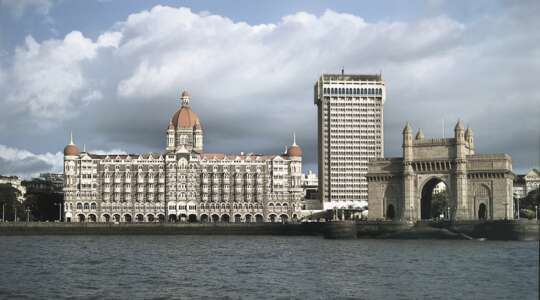
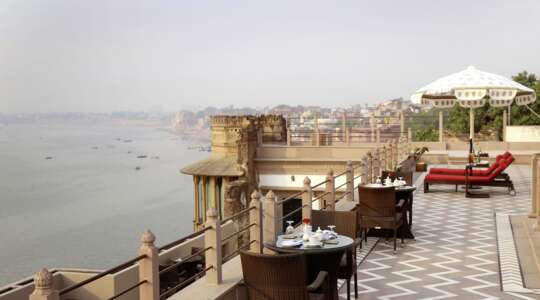










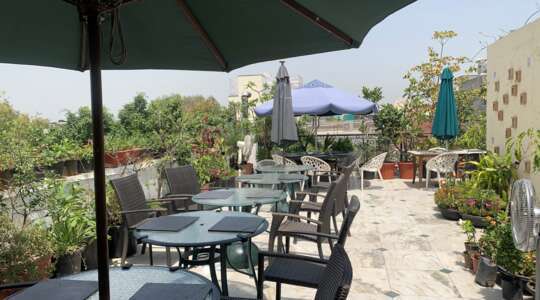

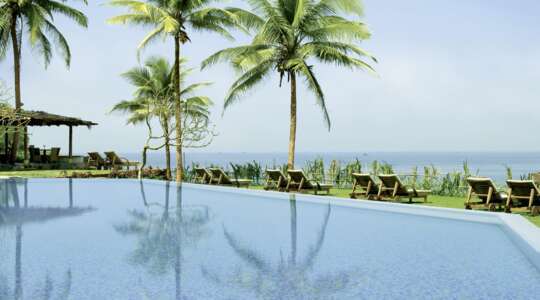
















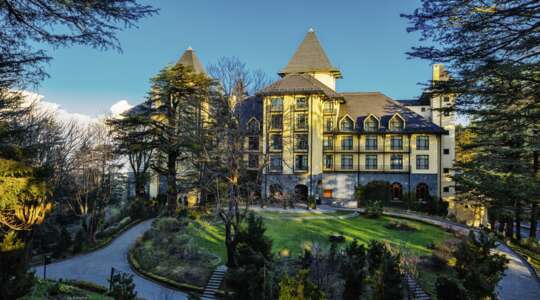










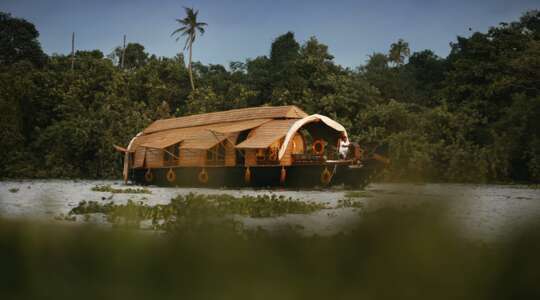


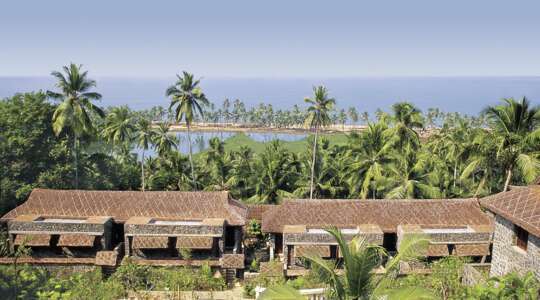

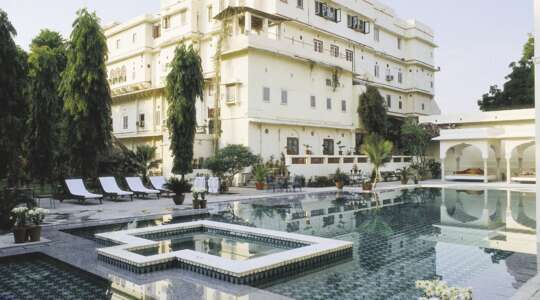
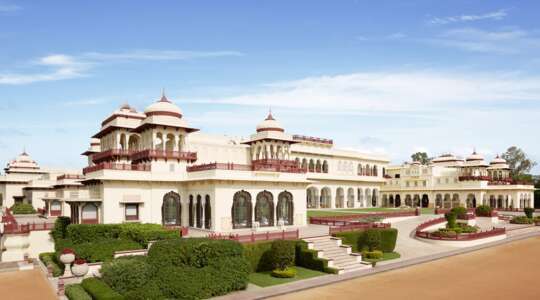


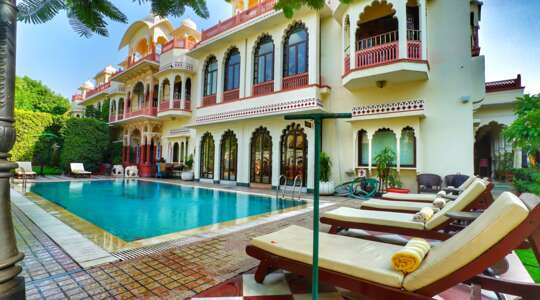













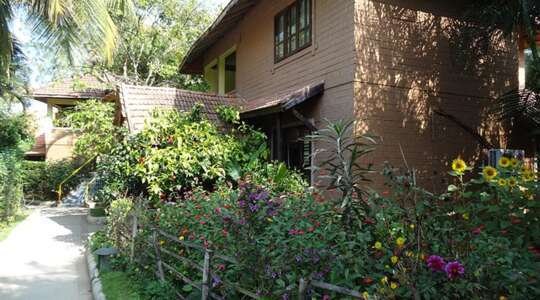



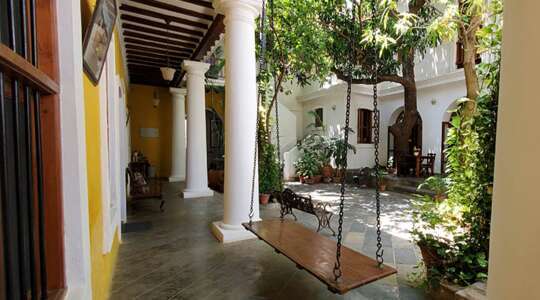


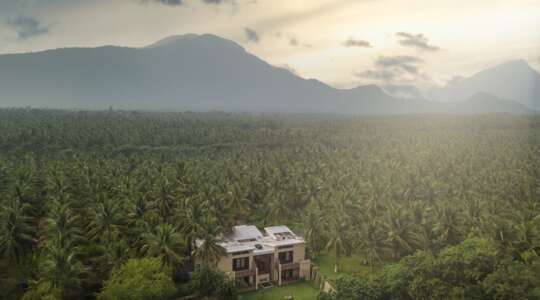
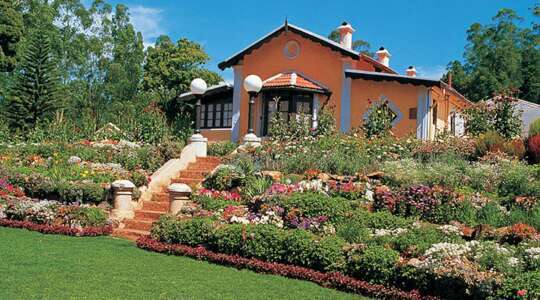


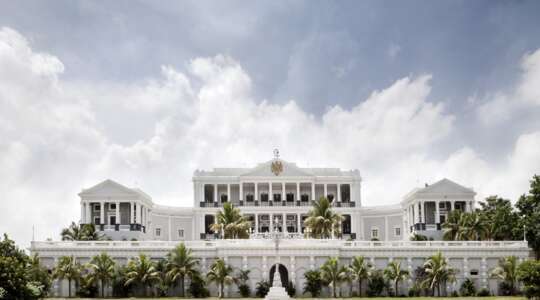

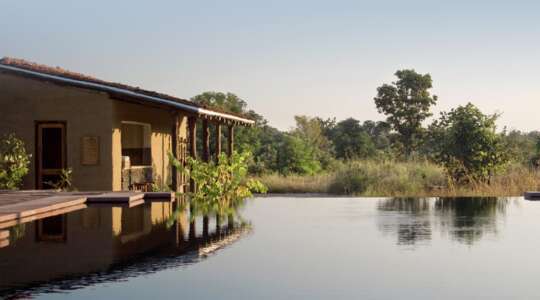




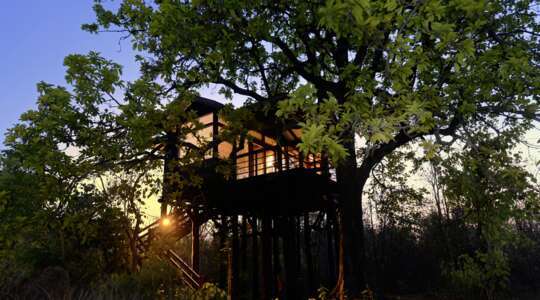




_w=126_h=31.png?v=d272c1958c6b4383fe76ca13ac1f42e2d91606e9)
_w=24_h=25.png?v=d272c1958c6b4383fe76ca13ac1f42e2d91606e9)
_w=24_h=25.png?v=d272c1958c6b4383fe76ca13ac1f42e2d91606e9)
_w=24_h=25.png?v=d272c1958c6b4383fe76ca13ac1f42e2d91606e9)
_w=24_h=25.png?v=d272c1958c6b4383fe76ca13ac1f42e2d91606e9)